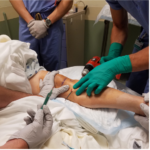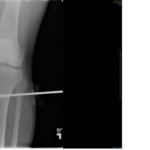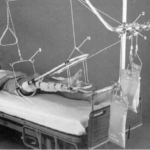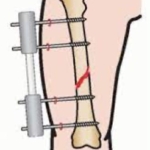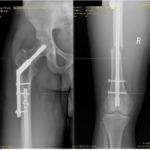Are you pulling my leg? -femur fractures
The Thomas splint was first introduced by Hugh Owen Thomas in 1875, in his book titled, Diseases of the hip, knee and ankle joints with their deformities, treated by a new and efficient method. Across the western front, the splint was adopted and by 1917, it had become standard issue to army medical teams.
The functional design of the Thomas splint has remained largely unchanged since its inception.
During WWII and Vietnam, before the days of Velcro, cravats (triangular bandages) were used to support the lower extremity and a special ankle hitch knot provided traction above the ankle to the end of the splint without compromising vascular flow. At the distal end of the splint a windlass was “MacGyvered” with anything available.
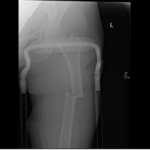
Pre-hospital treatment improved when the Hare was first developed in the 1960s by introducing a ratchet mechanism into the then-commonly used Thomas splint. Hare uses bipolar traction with bilateral steel rods that flank the limb.

The 1970s brought us the Sager. Unlike Hare, Sager applies unipolar traction with one steel rod and is placed between the patient’s legs, rather than posteriorly, thus accommodating both proximal and bilateral femur fractures.

Other manufacturers have similar devices also.
The treatment at that time was inserting traction pins through the tibia
A trapeze was built over the bed, a system of pulleys, ropes, sandbags and or lead weights were used to obtain alignment of the fracture and the patient remained that way for approximately 6 weeks for the bone to repair. To make things worse, in those days the urinals and bedpans were made of stainless steel.
Today hospital treatment is either external fixation
Or surgical intervention with rods or prosthetic replacement. Orthopedic OR is lot like wood shop-hammers, drills, saws, nails and screws.
References
Thomas “History of the Thomas Splint – Ortho Rhode Island.” 17 Feb. 2016,
https://www.orthopedicsri.com/2016217history-of-the-thomas-splint/.
Brown Emergency Medicine Gaining Traction with Femoral Shaft Fractures
http://brownemblog.com/blogposts/2016/10/28/vho4znj99egy7taz50kdr7t3k23lxw
EMS World, June 2020.
Robin Click-The difference between traction splints
Personal experience as a medic in Vietnam, Paramedic or Radiologic Technologist


